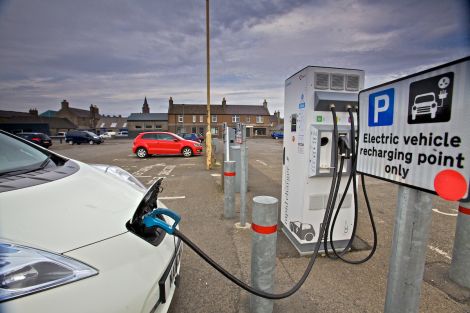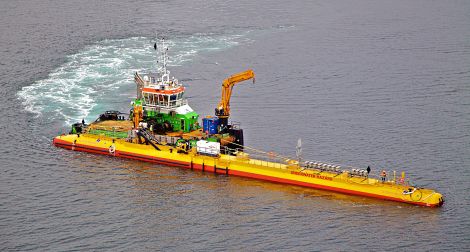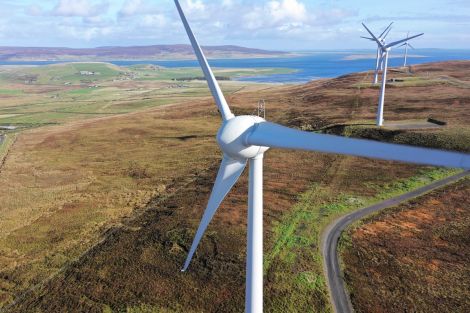Energy / Orkney plans community wind farm to pay for council services
While visiting Kirkwall for the election count last week, Shetland News editor Hans J Marter took the opportunity to speak to some of the main players in Orkney’s renewable energy industry to find out how our nearest neighbours are responding to the climate emergency.
FOR many years now Orkney has been seen as the islands where the grass is greener and where the renewable energy industry is making massive strides towards a better, greener future.
The islands are, of course, home to the European Marine Energy Centre (EMEC), the main marine test site globally, as well as Heriot Watt University’s International Centre for Island Technology (ICIT), a research and teaching centre for marine and renewable energy.
And then there are some medium sized wind farms and a flurry of smaller domestic turbines that all produce electricity, heat homes and charge a growing fleet of electric vehicles.
Orkney produces between 110 and 140 per cent of its electricity needs from renewable sources, Sweyn Johnston of Orkney Islands Council (OIC) confirms, but with carbon dioxide emissions of 192,500 tonnes annually (2017 figures) Orkney’s carbon footprint per person is still one of the highest in the UK, and is only slightly lower than Shetland’s at 235,900 tonnes (that’s without major industry and shipping).
Johnston is the council’s strategic projects director and in that role he, and others, have been working on Orkney’s low carbon agenda for a number of years.
Driven by the Orkney Needs Case, energy regulator Ofgem have approved plans by transmission company SSEN to upgrade Orkney’s at-capacity 50MW link to the national grid with a new 220MW transmission cable by 2024.
However, this will only happen if renewable energy projects with a total capacity of at least 135MW have managed to gain planning consent by the end of 2021.
Earlier this year, the OIC went public with plans for three 30MW community wind farms, each consisting of between five to seven very large turbines. The proposed sites are near Lyness, on the island of Hoy, on the uninhabited island of Faray, between Eday and Westray, as well as at Quanterness, just outside Kirkwall.
Become a member of Shetland News
Johnston concedes that particularly the Quanterness project will have a “relative large impact on the landscape of Orkney”, but he is confident that the selling points for the wind farms are strong enough to convince even the biggest sceptics.
These wind farms will not only help trigger the cable and thus act as an incentive for more innovative renewables projects on the islands, but they also form an essential part of Orkney Islands Council’s financial planning and future wellbeing.
With an estimated income of at least £2 million per wind farm per year, the projected profit of £6 million miraculously matches the OIC’s current budget deficit, which is currently paid for by the council’s own reserves.
Johnston and public engagement officer Kirsty Groundwater are adamant that the council will not be looking for an industry partner in developing these projects, and that all of the income will be used to pay for and maintain council services.
“I am sure the OIC can handle the loans necessary,” Johnston said. “There will be no private shareholders, and we are doing this without industry partners”, as all the necessary expertise can be bought in.
He is quick to assert that the issues around the Shetland Needs Case are different, acknowledging that capacity threshold needed to trigger a transmission link from Shetland to the Scottish mainland is significantly higher.
“Community benefit is front and centre of this project,” Groundwater said, adding that the council was “pro-actively doing something” to target the growing budget gap created by reduced government funding and ever-increasing demand for services.
The plans fit well into the Orkney sustainable energy strategy, which aims to improve Orkney’s transmission links to promote other forms of renewables such as marine energy and hydrogen based projects.
Decarbonising
As such decarbonising public transport is a major undertaking, with the Shapinsay ferry already running on a mixture on diesel and hydrogen, and the world’s first two hydrogen powered car and passenger ferries currently being built by shipbuilder Ferguson Marine Engineering at Port Glasgow.
The hydrogen needed for these projects come from renewable sources, produced by community-owned wind turbines as well as from the marine energy test site off the island of Eday.
Ian Johnstone, who works for renewable energy consultants Aquatera, another Stromness based business, and is also the chairman of the Orkney Renewable Energy Forum, said the marine energy sector has been going through a tough time after the previous Conservative government pulled subsidies a few years ago.
That left a number of projects stranded as they were still at the development stage and in dire need of public money combined with a strong industry partner. Nova Innovation, operating the Bluemull Sound tidal array, are one of the few that are relatively close to market maturity.
Johnstone said the Scottish Government had been trying “to fill some of the gap” while the UK Government had never recognised that the marine sector (tidal and wave) “was behind and needed support”.
“The UK’s wind industry needed 40 years to get where they are now,” he pointed out.
He said the forum, which has been a focal point for the local industry and its stakeholders for the last 20 years, has been ”pulling people together to discuss renewable energy issues”, speaking on behalf of the local industry as well as being partners in innovative projects such as ReFLEX, which was announced in spring this year.
Similar to the NINES project in Shetland, the £28 million ReFLEX (Responsive Flexibility) project aims to interlinking local electricity, transport and heat networks into one controllable overarching system to eventually eliminate the need for fossil fuels.
Led by the European Marine Energy Centre, ReFLEX brings together local partners such as Solo Energy, Aquatera, Community Energy Scotland, Heriot Watt University, the OIC as well as industry partner Doosan Babcock.
At the heart of the project is the demonstration of flexible energy balancing technologies by deploying:
- Up to 500 domestic batteries;
- Up to 100 business and large-scale batteries;
- Up to 200 vehicle-to-grid (V2G) chargers;
- Up to 600 new electrical vehicles (EVs);
- A community electric bus and e-bike integrated transport system;
- Up to 100 flexible heating systems; and
- a Doosan industrial-scale hydrogen fuel cell.
The ultimate aim is for local people to become ReFLEX customers by being on a local tariff, Johnstone said. “Consumers will at long last see the benefits from the renewable energy that is being produced in their own backyards.”
Become a member of Shetland News
Shetland News is asking its readers to consider paying for membership to get additional perks:
- Removal of third-party ads;
- Bookmark posts to read later;
- Exclusive curated weekly newsletter;
- Hide membership messages;
- Comments open for discussion.
If you appreciate what we do and feel strongly about impartial local journalism, then please become a member of Shetland News by either making a single payment, or setting up a monthly, quarterly or yearly subscription.



















